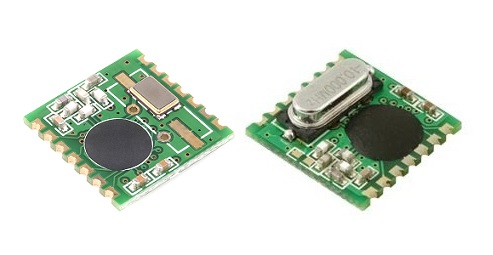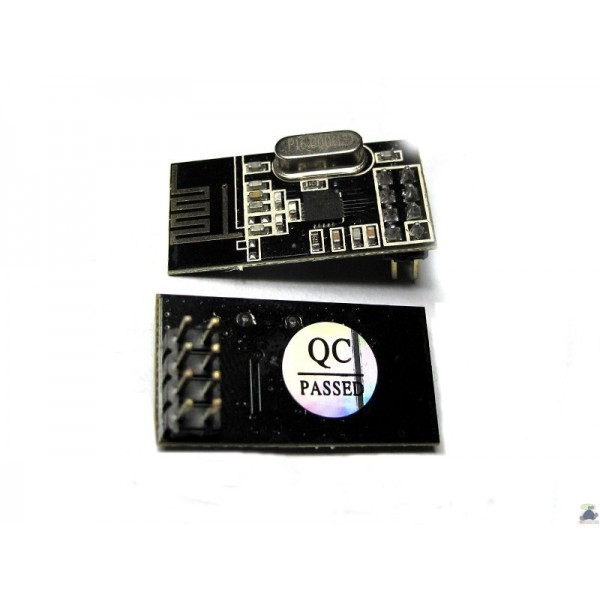EDIT March 2015: [It has been two years since this post, and the RFM12B is still widely available. I guess the rumors at that time were exaggerated widely.]
There has been bad news for the RFM12B ecosystem last week, namely the news that the RFM12B module has been declared in its End of Life. There has been forum/twitter discussions ever since and I am not sure anyone knows what that means, but for sure the RFM12B modules and especially the ‘flat crystal’ version have gone “out of stock” for both my suppliers. I have contacted the manufacturer Hope RF, and they recommended using RFM69W instead. This is silly, as the two are not compatible, neither it is available to purchase anywhere in the EU at the time I write this. Another fact that they mentioned is that the “big crystal” version of the RFM12B is their “high run” version, so it will probably be out there for longer time. Who knows until when. I personally use the “flat crystal” version as it allows keeping very low profile: a requirement for the Funky v2 when used with a CR2032 battery holder where the big crystal version will stand on the way.
I must say that this is not unexpected for me. I don’t think the RFM12B is the best solution out there anyway and have been keeping an eye for alternatives. Top of my list were TI’s CC1101 and Nordic Semiconductor’s nRF24L01. Since the nRF24L01 is a magnitude cheaper, I decided to give it a try. Two modules cost $3 delivered, this is simply unbeatable. If I am to sprinkle the house with wireless nodes, price matters. The CC1101 modules start at $5.50 per piece for comparison sake.
The nRF2401 has some distinct advantages over the good old RFM12B
- 32 byte separate RX/TX FIFOs compared to a two byte shared TX/RF FIFO on the RFM12B. This means less MCU involvement therefore lower power consumption.
- 11mA/12mA RX/TX consumption compared to 14mA/23mA on the RFM12B
- 1.9 – 3.6V supply compared to 2.2 – 3.8 V on the RFM12B
- Single 2.4Ghz band version vs the multiple versions for RFM12B (433, 868, 915)
- Hardware packet management: ACK, CRC, retrasmissions of lost packages.
- 5V tolerant pins
Sure enough there is AVR/Arduino library already available.
I have purchased couple nRF24s and will experiment once I get my hands on them.



Hi Martin
Thank you for sharing this info. Indeed at €2.44/pair the price is unbeatable.
Also the product’s name, nRF24L01, half-matches with my nRfMon spectrum analyzer tool, so I may give it a try too and see how I can make it work with the new transceiver. I’m looking forward to your experiments.
Cheers!
Dimitrios
I had a look in the docs and it seems there is no measurement of RSSI available to the user so nRfMon cannot be adapted to work with this module.
True, this is what I find on the Internet regarding this:
There is a 1-bit “collision detect” flag that warns if the RF energy on the current channel is above a set threshold (in the RPD register 09, is a single bit RSSI. If Bit 0 of register 09 is clear then received signal level is below -64dBm & when set it’s above -64dBm. )
Is the rfm70s not à good replacement also?
I had a look at the RFM70 earlier, it seems to use very similar chip (BK2421vs nRF24L01) see http://www.forbot.pl/forum/download.php?id=1277. The price is a bit higher compared to what I could get on ebay and only limited quantities too. And I am unhappy with HopeRF anyway, so looking forward to move away from them.
Hi,
Do you think that GPIO pinout-wise the nRF24L01 could co-exist with the RFM12Pi (v1) board on a single Raspberry Pi? Maybe a small perfboard contraption could be made to make them sandwich nicely on top of a Pi.
Apparently there already are C and Python libraries to use nRF24L01 from Pi.
They are both SPI devices and probably can co-exist; I was rather thinking of experimenting with a RFM12 to nRF23L01 bridge using an Atmega 328. This way we won’t overload the Raspberry
ops, I just noticed you mention RFM2Pi v1 board, so the two can surely co-exist”
If you take the smaller ones, ie these: http://img.dxcdn.com/productimages/sku_149253_1.jpg, it could almost be a drop-in replacement for the RFM12B…
Be aware that the Nordic Semiconductor’s nRF24L01 has been marked by the manufacturer as “not recommended for new designs” – it would make sense to look for the current model, which is the nRF24L01+.
Thanks,
this is good to know. The breakout modules appear pin-compatible at quick glance.
Pingback: Dirt Cheap Low Power Wireless Sensor Node using nRF24L01+ 2.4GHz | Martin's corner on the web
Also importantly, the Nordic board has pins on a standard 0.100″ grid! Not a single row, alas, but we’ll survive somehow. A boon for experimenters regardless.
The 2mm stuff baffles me; it’s not THAT much smaller than 2.54mm, and it makes prototyping a PITA. I’m looking at you, XBee!
Pingback: nRF24L01 2.4Ghz wireless modules | Geek Grandad
I was just checking the HopeRF web site and it seems they had a change of heart. According to this page: http://www.hoperf.com/rf/fsk_module/RFM12B.htm. You can see at the bottom of the page the following message:
Notice : We have no plan to discontinue this item for the coming years, in case in the future we decide to stop the production of this item, we will issue a notice in public in advance for 24 months.
So hopefully we are good for a while yet…
I just purchased a couple of RFM12B Breakout Boards (http://modtronicsaustralia.com/shop/rfm12b-breakout-board-wireless-module/) from these guys, for a little Arduino project I’m working away on and they confirmed the RFM12B hadn’t gone end of life.
So it certainly looks like HopeRF are going to continue support for it, at least in the near term, which is good to see.
RFM12B is NOT End Of Life, but rather tier 4 manufacturing status—meaning, it requires a higher minimum order requirement to purchase and requires payment upfront. There is NO plan to phase out this product in the near future. I am an official distributor of hopeRF products, and the rumor of end of life is simply not correct. HopeRF however recommends the RFM69 as replacement, why? 1) it has greater profit margin for Hope and they want it to be a flagship product with several footprint variations. 2) It’s newer and has higher performance then the rfm12b.
We have Thousand of RFM12B in stock, and plan to supply them for the foreseeable future. We also offer best pricing on these.